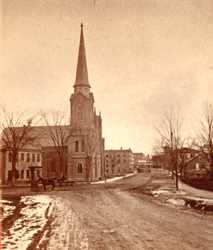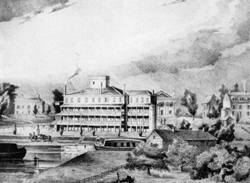
Bridge Street Cemetery Northampton Architecture Historic Markers 
|


Upper Main Street
 |
| Upper Main Street in the 1870s |
Commercial development along upper Main Street followed the industrial expansion spurred by the Civil War. As Northampton became a manufacturing center, its business district expanded to accommodate a growing and changing population. In the 1860s and 70s, the commercial blocks opposite Pulaski Park were built on the old Lyman family homestead. Designed by William Fenno Pratt, these brick structures reflect the practical sensibilities of Victorian merchants.
 |
| Edwards Church in the 1870s looking from Smith College |
The present Edwards Church at the corner of Main and State Streets, built in 1958, replaced a Victorian structure erected in 1872. A prominent spire covered with bold patterns of multi-colored slate surmounted the brick Gothic Revival structure. When President Calvin Coolidge died in 1933, the church was the site of his funeral. Crowds thronged the street to witness the visiting dignitaries. President Herbert Hoover attended as did Eleanor Roosevelt, wife of President-elect Franklin D. Roosevelt.
 |
| In the 1820s, the New Haven and Northampton Canal followed present day State Street. |
On the far side of the Main and State Street intersection is the site of the terminus of the
New Haven and Northampton Canal. Begun in 1822 and completed in 1835, it remained in service until 1847. Inspired by the success of the Erie Canal, local investors hoped that a direct connection with the seaport of New Haven, bypassing the rapids and falls of the Connecticut River, would prove to be a commercial success. Their hopes were dashed by the railroad, which came to Northampton in 1845. The Mansion House, a four story hotel and depot built by Isaac Damon to serve the needs of the expected influx of travelers, stood on what is now the site of St. Mary’s Church rectory.
Contents Historic Northampton.